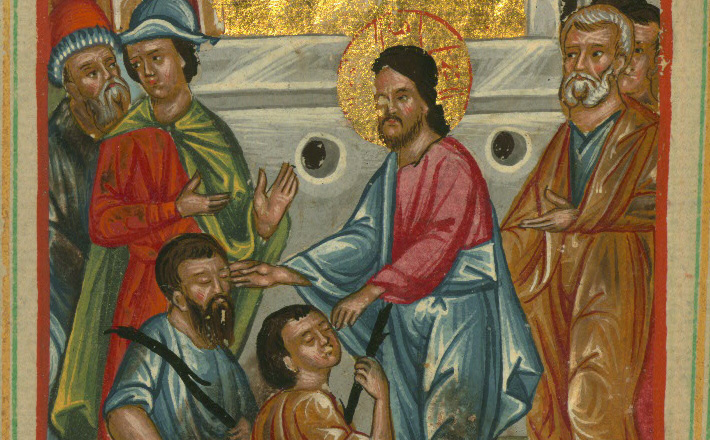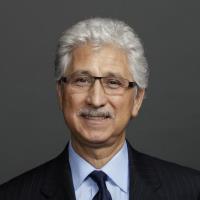Commentary on John 9:1-41
John 9 functions as a commentary on Jesus’s claim in 8:12 (“I am the light of the world”).
Verse 5 ties John 8 and 9 together. As in John 3 and 4, religious instruction is conveyed through dialogue, a literary devise present in Rabbinic and Hellenistic documents as well as in the Jesus tradition.
This chapter can be divided into three sections: introduction to the healing (1-5), description of the healing (6-7), and reaction to the healing (8-41). Like in John 4, there are several characters: the blind man, Jesus, the disciples, the Pharisees, and the blind man’s parents.
Punctuation and interpretation
How John 9:3 is punctuated makes a difference in the way one interprets this incident. The NRSV, by adding he was born blind, which is not in the Greek text, suggests that the man’s blindness is an “excuse” for God to show God’s power (see also 11:4). A more accurate translation would be “Neither this man nor his parents sinned. But in order that God’s works might be revealed in him it is necessary for us to work the works of the one who sent me … ”
This translation conclusively affirms that, at least in this case, there is no connection between sickness and sin (but see 5:14). Therefore, Jesus must do the work of God and heal the man.
In the Jewish tradition, there were two causes for sickness: the sins of the parents which produced the suffering of the children (Exodus 20:5) and prenatal sin committed by the fetus. The latter was an older tradition from the Rabbinic period. But in Israel there were differences of opinion on this matter, as suggested by Ezekiel 18 and Jeremiah 31:29-30. In this passage, Jesus seems to side with the prophetic traditions that affirmed that people were individually responsible for their sins.
The symbolism behind the man’s story
In reading the Gospel of John, ancient as well as contemporary readers are used to expect more than the obvious. So, when it comes to understanding what the blind man stands for, there are a variety of possible interpretations.
Since the purpose of signs in John is to teach about Christology, the giving of sight to a blind man teaches people that Jesus is the light of the world in a similar fashion that the multiplication of loaves in chapter 6 shows that Jesus is the bread of life.1 The only way people can approach the light of God shown in the person of Jesus is acknowledging their own blindness. Approaching Jesus pretending to know (Nicodemus) or to see (Pharisees) amounts to spiritual blindness. This chapter, but also the Gospel in general, exemplifies the movement from unbelief to belief. With his declaration in verse 38, “Lord, I believe,” the man demonstrates the kind of faith that is required for salvation. The same kind of confession is shown by Martha in 11:27.
The man is a foil for the blindness of the Pharisees, a poignant example of the irony of the Fourth Gospel and the humor of the region: a blind man who sees what the religious authorities do not (cf. 39-41). The chapter starts with a man born blind assumed to be a sinner (verse 2) and ends with some of the Pharisees who are declared sinners because they pretend to “see,” which shows their unbelief (verses 39-41). As the chapter progresses, “blindness” moves from a physical to a spiritual level. By the end, the blind man not only sees in a physical way but also believes, receives spiritual light (see Ephesians 5:8-14). Again, we see the amazing piling up of symbolisms in John’s rhetoric.
Sending the man to wash himself in the pool of Siloam recalls the incident in 2 Kings 5:10-14, where Naaman the leper is sent by Elisha to bathe in the river Jordan. It also emphasizes the healing power of water, since the man is healed only after he washes himself, an act of trusting obedience. That is why, in the early church, this story was read during the baptism of new converts. Some scholars even believe that verses 38-39 were added later for precisely that purpose. In fact, this story appears in early catacomb art most frequently as an illustration of Christian baptism.2
There is evidence in the gospel that the evangelist had in mind a baptismal motif. The name of the pool means sent and in John Jesus is the one who was sent from God. Also, the water of the pool was the source of the water used in the celebration of Tabernacles and the reader has learned from 7:37-38 that Jesus, during the last day of the festival, declares himself to be the source of living water, thus symbolically replacing the water of the festival with his own person.
One of the most popular interpretations of this chapter is that the man is not a real historical character but a literary construction reflecting the situation of the Johannine community when it was forcefully separated from the synagogue. This is based on 9:22 and 34, but also on 12:42-43 and 16:2. Being as it may, the separation does not have to be understood in terms of expulsion but perhaps as a voluntary separation. This possibility takes the responsibility for the rift off the Jewish people and puts it on the community (also Jewish), which found it impossible to remain in communion with their brothers and sisters in the synagogue because of their developing Christology, an example of which can be seen in the man’s progressive understanding of who Jesus was (see 9:11,17, 33 and 38).
As we ponder about the appropriateness of this text for contemporary audiences we need to consider several things. First, the text seems to combat the idea that sickness is related to sin. In an age that has seen the spread of AIDS and other sexually transmitted diseases, which for many people represent a sinful lifestyle, it would be wise not to make this mistake ourselves.
Second, the man was a social outcast on the assumption that his physical and social conditions were the consequence of his or his parents’ sin. He was put in this position by a culture that did not give him enough opportunities to support himself in a dignified manner. But Jesus is about to change all that with a miracle that speaks of the healing power of the marginalized. Both Jesus and the man were considered sinners by popular culture (9:2, 24,34) and yet they are the protagonists of a liberating event.
Third, the text seems to reject also all kinds of determinisms, that is, the idea that one’s race, culture, social status, education, among other things, determine one’s moral standing. One example of this was the 2010 earthquake in Haiti which brought about a great devastation in that country. Some conservative preachers interpreted it as a divine punishment for their practice of Voodoo and other nature religions, instead of seeing it as a natural catastrophe that affected thousands of people, especially the poor. Another example is the fact that most of the inmates in the US prison system are African Americans and Latinos. This should not be seeing as a commentary on their morality but rather as proof of the racial prejudices of our society when it comes to decide who goes to prison and who doesn’t.
Lastly, a Pharisaic attitude is not the domain of Judaism alone, but of any religion going legalistic. We need to avoid equating the Pharisees with the Jews, who in the gospel of John refer not to the Jewish people in general but to the Jewish religious authorities who were bent on prohibiting new ways of interpreting the traditions of Israel.
Notes:
1 Talbert, Reading John, 162.
2 Brown, John, 380.


March 26, 2017